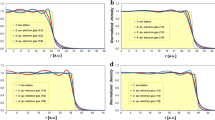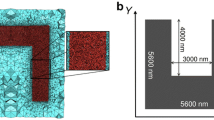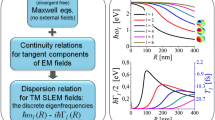Abstract
In this study we propose a theory of nonlinear plasmonic oscillations in metal nanoparticles subjected to optical irradiation which is further reduced to solvable mathematical model by applying variational procedures and numerical methods. One of the goals pursuing under construction of the theory has been to minimize its axiomatics. A governing equation of motion is deduced on the basis of the least action principle and supplemented by a continuity equation that results from variational and differential formulations of charge conservation. The presence of irreversible processes is taken into account by leveraging of a polynomial dissipation term embedded into the action functional. An initial boundary value problem formulation for nonlinear integrodifferential equations constituting the model of electron gas dynamics has been given. On the ground of a finite-difference approximation an iterative method for treating the problem as well as the algorithm and solver code have been worked out. By utilizing these tools we investigate the third order field effects such as third harmonic generation and four-wave mixing by a group of metal nanoparticles illuminated by a multispectral source of light. An excitation of transverse–longitudinal mode of plasmonic oscillations has been observed under plane wave illumination of two spherical particles. The charge and current distributions intrinsic to the mode have been investigated numerically together with an electromagnetic field scattered by the particles into far zone. The estimate of the density function parameter providing regular dynamics has been analytically obtained by the contraction principle.








Similar content being viewed by others
References
Akhmediev, N.N., Ankiewicz, A.: Solitons, Nonlinear Pulses and Beams, p. 352. Chapman and Hall, London (1997)
Baranov, A.A., Kolpashchikov, V.L.: Reliativistskaia termomekhanika sploshnykh sred [Relativistic Thermomechanics of Continuum Media], p. 152. Moscow, Editorial URSS (2003)
Bredov, M.M., Rumyantsev, V.V., Toptigin, I.N.: Klassicheskaya elektrodynamika [Classical Electrodynamics], p. 400. Lan, St.Petersburg (2003)
Drachev, V.P., Chettiar, U.K., Kildishev, A.V., Yuan, H.K., Cai, W., Shalaev, V.M.: The Ag dielectric function in plasmonic metamaterials. Opt. Express 16(2), 1186–1195 (2008). doi:10.1364/OE.16.001186
Garrett, N., Whiteman, M., Moger, J.: Imaging the uptake of gold nanoshells in live cells using plasmon resonance enhanced four wave mixing microscopy. Opt. Express 19(18), 17563–17574 (2011). doi:10.1364/OE.19.017563
Ghirardi, G., Romano, R.: Is a description deeper than the quantum one possible? Phys. Scr. T163, 014028 (2014). doi:10.1088/0031-8949/2014/T163/014028
Hoban, M.J., Wallman, J.J., Browne, D.E.: Generalized Bell-inequality experiments and computation. Phys. Rev. A 84, 062107 (2011). doi:10.1103/PhysRevA.84.062107
Johnson, P.B., Christy, R.W.: Optical constants of the noble metals. Phys. Rev. B 6, 4370 (1972). doi:10.1103/PhysRevB.6.4370
Kohn, W.: Nobel Lecture: electronic structure of matter—wave functions and density functionals. Rev. Mod. Phys. 71(5), 1253–1266 (1999). doi:10.1103/RevModPhys.71.1253
Kullock, R., Hille, A., Haußmann, A., Grafström, S., Eng, L.M.: SHG simulations of plasmonic nanoparticles using curved elements. Opt. Express 19(15), 14426–14436 (2011). doi:10.1364/OE.19.014426
Landau, L.D., Lifshitz, E.M.: Course of Theoretical Physics: Statistical Psshysics (Part 1: Vol. 5), p. 544. Butterworth-Heinemann, Oxford (1980)
Landau, L.D., Lifshitz, E.M.: Course of Theoretical Physics: Quantum Mechanics, vol. 3, p. 689. Butterworth-Heinemann, Oxford (1981)
Lippitz, M., van Dijk, M.A., Orrit, M.: Third-harmonic generation from single gold nanoparticles. Nano Lett. 5(4), 799–802 (2005). doi:10.1021/nl0502571
Maier, S.A.: Plasmonics: Fundamentals and Applications, p. 223. Springer, New York (2007)
Nikiforov, A.F., Novikov, V.G., Uvarov, V.B.: Quantum—Statistic Models of Hot Dense Matter and Methods for Computation Opacity and Equation of State, p. 400. Fizmatlit, Moscow (2000)
Noskov, R.E., Krasnok, A.E., Kivshar, YuS: Nonlinear metal-dielectric nanoantennas for light switching and routing. New J. Phys. 14(9), 093005 (2012). doi:10.1088/1367-2630/14/9/093005
Ol’hovskij, I.I.: Kurs teoreticheskoi mehaniki dlia fizikov [Course of Theoretical Mechanics for Physicists], p. 575. Lomonosov Moscow State University, Moscow (1978)
Pakdel, S., Miri, M.: Faraday rotation and circular dichroism spectra of gold and silver nanoparticle aggregates. Phys. Rev. B 86, 235445 (2012). doi:10.1103/PhysRevB.86.235445
Renger, J., Quidant, R., Novotny, L.: Enhanced nonlinear response from metal surfaces. Opt. Express 19(3), 1777–1785 (2011). doi:10.1364/OE.19.001777
Schumacher, T., Kratzer, K., Molnar, D., Hentschel, M., Giessen, H., Lippitz, M.: Nanoantenna-enhanced ultrafast nonlinear spectroscopy of a single gold nanoparticle. Nat. Commun. 2, 333 (2011). doi:10.1038/ncomms1334
Sedov, L.I.: A course in Continuum Mechanics, vol. 1. Wolters-Noordhoff, the Netherlands (1971)
Serebrennikov, A.M.: On the nonlinear mechanoplasmonic theory of frequency scaling and mixing effects. Plasmonics 8(3), 1299–1308 (2013). doi:10.1007/s11468-013-9522-1
Weber, W.H., Ford, G.W.: Propagation of optical excitations by dipolar interactions in metal nanoparticle chains. Phys. Rev. B 70, 125429 (2004). doi:10.1103/PhysRevB.70.125429
Xu, T., Jiao, X., Blair, S.: Third-harmonic generation from arrays of sub-wavelength metal apertures. Opt. Express 17(26), 23582–23588 (2009). doi:10.1364/OE.17.023582
Zheng, M.J., Xiao, J.J., Yu, K.W.: Tunable localization and oscillation of coupled plasmon waves in graded plasmonic chains. J. Appl. Phys. 106, 113307 (2009). doi:10.1063/1.3268459
Author information
Authors and Affiliations
Corresponding author
Appendices
Appendix 1
The momentum density function can be derived from the current density \( {\mathbf{j}} = ({{\partial {\mathbf{u}}} \mathord{\left/ {\vphantom {{\partial {\mathbf{u}}} {\partial t}}} \right. \kern-0pt} {\partial t}}) \cdot {{\partial \uprho } \mathord{\left/ {\vphantom {{\partial \uprho } {\partial \,({\mathbf{u}}\nabla )}}} \right. \kern-0pt} {\partial \,({\mathbf{u}}\nabla )}} \) by multiplying by a constant factor as: \( (m/e)\,{\mathbf{j}} \). Analogously, the mass density function holds as: \( (m/e)\,\uprho \). Thus a kinetic energy of the continuum of density can be expressed by the sum \( T = T_{1} + T_{2} \), where \( T_{1} \; = \;\;\frac{m}{e}\;\int_{{R^{3} }} {\;\frac{{{\mathbf{j}} \cdot {\mathbf{j}}}}{2\uprho }\;d{\mathbf{r}}} \) corresponds to a classic representation; \( T_{2} = \frac{m}{e}\int_{{R^{3} }} {\uprho F(\uprho )d{\mathbf{r}}} \) is a correction term in which \( F(\uprho ) \) stands for a twice differentiable function with a power representation intrinsic to statistical physics (Landau and Lifshitz 1980). The interaction energy between an electron gas and a light wave has the form: \( \varPi_{1} = \int_{{\,R^{3} }} {\left\{ { - {\mathbf{j}} \cdot {\mathbf{A}} + \uprho \uppsi } \right\}d{\mathbf{r}}} \), where the field potentials are prescribed to the state element \( {\mathbf{u}}({\mathbf{r}},t) \) as: \( \uppsi \,({\mathbf{u}},\;t) \), \( {\mathbf{A}}\,({\mathbf{u}},\;t) \). Coulomb interaction in the “electron gas-electron gas” system can be expressed as:
Coulomb energy of the “ionic frame-electron gas” system is in turn:
The total Coulomb energy is thus the sum: \( \varPi_{2} = \varPi_{2}^{ee} + \varPi_{2}^{ie} \). The exchange interaction in the electron gas can be introduced via the exchange-correlation energy term defined as: \( \varPi_{3} = \int_{{\,R^{3} }} {\uprho ({\mathbf{u}},\;{\mathbf{u}}\nabla ,\;t)\;\upvarphi_{xc} ({\mathbf{u}},t)\;d{\mathbf{r}}} \), where \( \upvarphi_{xc} \) is the exchange potential. (In this work it is assumed to be zero.) By combining energy terms one defines the lagrangian of the “ionic frame-electron gas-light field” system as: \( L = T - \varPi_{1} - \varPi_{2} - \varPi_{3} = \int_{{\,R^{3} }} {\Lambda ({\mathbf{u}},\;{{\partial {\mathbf{u}}} \mathord{\left/ {\vphantom {{\partial {\mathbf{u}}} {\partial t}}} \right. \kern-0pt} {\partial t}},\;{\mathbf{u}}\nabla ,\;t)\;d{\mathbf{r}}} \), where \( \Lambda \) stands for the lagrangian volumetric density.
Appendix 2
Let us demonstrate the technique of the Euler–Lagrange derivative (10) calculus by the example of one of its terms, namely: \( \frac{{\partial ({\mathbf{j}} \cdot {\mathbf{A}})}}{{\partial \,({\mathbf{u}}\nabla )}} \cdot \nabla.\) By using the index form of denotation of tensor analysis, make the following transformation:
Taking the divergence operator from (27) one takes:
By transforming the first term in the r.h.s. of (28) one obtains: \( A_{i,q} \,j_{i,pq} \;{\mathbf{e}}_{p} = A_{l,k} \;{\mathbf{e}}_{k} {\mathbf{e}}_{l} \cdot \cdot j_{i,pq} \;{\mathbf{e}}_{i} \,{\mathbf{e}}_{q} {\mathbf{e}}_{p} = \;(\nabla {\mathbf{A}}) \cdot \cdot \;\frac{{\partial \,{\mathbf{j}}}}{{\partial \,(\nabla {\mathbf{u}})}}. \) Similar operations done for the second term result in:
Thus (28) can be written as:
The form (29) is not final, because the method of calculation of the derivative \( \frac{{\partial {\mathbf{j}}}}{{\partial \,({\mathbf{u}}\nabla )}} \) has not been formulated so far. By using the expression of current density \( {\mathbf{j}} = ({{\partial {\mathbf{u}}} \mathord{\left/ {\vphantom {{\partial {\mathbf{u}}} {\partial t}}} \right. \kern-0pt} {\partial t}}) \cdot {{\partial \uprho } \mathord{\left/ {\vphantom {{\partial \uprho } {\partial \,({\mathbf{u}}\nabla )}}} \right. \kern-0pt} {\partial \,({\mathbf{u}}\nabla )}} \) complete the following transforms: \( \frac{{\partial {\mathbf{j}}}}{{\partial \,({\mathbf{u}}\nabla )}} = (j_{k} \;{\mathbf{e}}_{k} ),_{pq} \,{\mathbf{e}}_{p} \,{\mathbf{e}}_{q} = v_{i} \;\uprho_{ij,pq} \;{\mathbf{e}}_{j} \,{\mathbf{e}}_{p} \,{\mathbf{e}}_{q} = v_{k} \,{\mathbf{e}}_{k} \cdot \uprho_{ij,pq} {\mathbf{e}}_{i} \,{\mathbf{e}}_{j} \,{\mathbf{e}}_{p} \,{\mathbf{e}}_{q} = {\mathbf{v}} \cdot \frac{{\partial^{2} \uprho }}{{\partial \,({\mathbf{u}}\nabla )\,\partial \,({\mathbf{u}}\nabla )}} \), in which the denotation: \( \frac{\partial \uprho }{{\partial \,({\mathbf{u}}\nabla )}} = \frac{\partial \uprho }{{\partial \,(u_{i,j} )}}\;{\mathbf{e}}_{i} \,{\mathbf{e}}_{j} = \uprho_{ij} \;{\mathbf{e}}_{i} \,{\mathbf{e}}_{j} \) has been used. Identity (11) written in the index form: \( \uprho \;\delta_{il} \;{\mathbf{e}}_{i} \,{\mathbf{e}}_{l} = \uprho_{ij} \;\left( {\delta_{jl} + u_{l,j} } \right)\;{\mathbf{e}}_{i} \,{\mathbf{e}}_{l} \) should be used next. By its differentiation by \( {\mathbf{u}}\nabla \) one defines:
Taking into account that \( \frac{{\partial u_{l,j} }}{{\partial u_{p,q} }} = \delta_{lp} \;\delta_{jq} \) as well as \( u_{l,j} = \delta_{jl} \) and \( \uprho_{ij} = ({1 \mathord{\left/ {\vphantom {1 2}} \right. \kern-0pt} 2})\;\uprho \;\delta_{ij} \) (that goes from (12) at: \( dt^{\prime} \to 0 \)) one can proceed from (30) to the following identity: \( \uprho_{ij,pq} = ({1 \mathord{\left/ {\vphantom {1 4}} \right. \kern-0pt} 4})\,\uprho \left\{ {\delta_{ij} \;\delta_{pq} - \delta_{iq} \;\delta_{jp} } \right\}. \) With its use one takes: \( \frac{{\partial {\mathbf{j}}}}{{\partial \,({\mathbf{u}}\nabla )}} = v_{k} \,{\mathbf{e}}_{k} \cdot \uprho_{ij,pq} \;{\mathbf{e}}_{i} \,{\mathbf{e}}_{j} \,{\mathbf{e}}_{p} \,{\mathbf{e}}_{q} = ({1 \mathord{\left/ {\vphantom {1 4}} \right. \kern-0pt} 4})\,\uprho \;\left\{ {v_{j} \;\delta_{pq} - v_{q} \;\delta_{jp} } \right\}\;{\mathbf{e}}_{j} \,{\mathbf{e}}_{p} \,{\mathbf{e}}_{q}. \) Thereby the final solution for the first term in (29) has the form (the second can be written in a similar way and is not shown):
Rights and permissions
About this article
Cite this article
Serebrennikov, A.M. Four-wave mixing and transverse–longitudinal oscillatory modes in plasmonic nanoparticles: nonlinear theory from variational principles and mathematical simulation. Opt Quant Electron 47, 3567–3587 (2015). https://doi.org/10.1007/s11082-015-0231-1
Received:
Accepted:
Published:
Issue Date:
DOI: https://doi.org/10.1007/s11082-015-0231-1




